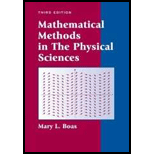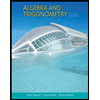
Mathematical Methods in the Physical Sciences
3rd Edition
ISBN: 9780471198260
Author: Mary L. Boas
Publisher: Wiley, John & Sons, Incorporated
expand_more
expand_more
format_list_bulleted
Textbook Question
Chapter 6.7, Problem 10P
Calculate the Laplacian
Expert Solution & Answer
Want to see the full answer?
Check out a sample textbook solution
Chapter 6 Solutions
Mathematical Methods in the Physical Sciences
Ch. 6.3 - If A=2ijk,B=2i3j+k,C=j+k, find (AB)C,A(BC),(AB)C,...Ch. 6.3 - For Problems 2 to 6, given A=i+j2k,B=2ij+3k,C=j5k:...Ch. 6.3 - For Problems 2 to 6, given A=i+j2k,B=2ij+3k,C=j5k:...Ch. 6.3 - For Problems 2 to 6, given A=i+j2k,B=2ij+3k,C=j5k:...Ch. 6.3 - For Problems 2 to 6, given A=i+j2k,B=2ij+3k,C=j5k:...Ch. 6.3 - For Problems 2 to 6, given A=i+j2k,B=2ij+3k,C=j5k:...Ch. 6.3 - A force F=2i3j+k acts at the point (1,5,2). Find...Ch. 6.3 - Prob. 8PCh. 6.3 - Prob. 9PCh. 6.3 - In Figure 3.5, let r be another vector from O to...
Ch. 6.3 - Write out the twelve triple scalar products...Ch. 6.3 - (a) Simplify ( AB)2[(AB)B]A by using ( 3.9). (b)...Ch. 6.3 - Prove that the triple scalar product of (AB),(BC),...Ch. 6.3 - Prove the Jacobi identity: A(BC)+B(CA)+C(AB)=0....Ch. 6.3 - Prob. 15PCh. 6.3 - In the discussion of Figure 3.8, we found for the...Ch. 6.3 - Expand the triple product for a=(r) given in the...Ch. 6.3 - Two moving charged particles exert forces on each...Ch. 6.3 - The force F=i+3j+2k acts at the point (1,1,1). (a)...Ch. 6.3 - Prob. 20PCh. 6.4 - Verify equations (4.5) by writing out the...Ch. 6.4 - Let the position vector (with its tail at the...Ch. 6.4 - As in Problem 2, if the position vector of a...Ch. 6.4 - Prob. 4PCh. 6.4 - The position of a particle at time t is given by...Ch. 6.4 - The force acting on a moving charged particle in a...Ch. 6.4 - Sketch a figure and verify equation ( 4.12).Ch. 6.4 - In polar coordinates, the position vector of a...Ch. 6.4 - The angular momentum of a particle m is defined by...Ch. 6.4 - If V(t) is a vector function oft, find the...Ch. 6.6 - Find the gradient of w=x2y3z at (1,2,1).Ch. 6.6 - Starting from the point (1,1), in what direction...Ch. 6.6 - Find the derivative of xy2+yz at (1,1,2) in the...Ch. 6.6 - Find the derivative of zexcosy at (1,0,/3) in the...Ch. 6.6 - Find the gradient of =zsinyxz at the point...Ch. 6.6 - Find a vector normal to the surface x2+y2z=0 at...Ch. 6.6 - Find the direction of the line normal to the...Ch. 6.6 - (a) Find the directional derivative of =x2+sinyxz...Ch. 6.6 - (a) Given =x2y2z, find at (1,1,1). (b) Find the...Ch. 6.6 - For Problems 10 to 14, use a computer as needed to...Ch. 6.6 - For Problems 10 to 14, use a computer as needed to...Ch. 6.6 - For Problems 10 to 14, use a computer as needed to...Ch. 6.6 - For Problems 10 to 14, use a computer as needed to...Ch. 6.6 - For Problems 10 to 14, use a computer as needed to...Ch. 6.6 - Repeat Problem 14b for the following points and...Ch. 6.6 - Show by the Lagrange multiplier method that the...Ch. 6.6 - Find r, where r=x2+y2, using ( 6.7) and also using...Ch. 6.6 - As in Problem 17, find the following gradients in...Ch. 6.6 - As in Problem 17, find the following gradients in...Ch. 6.6 - As in Problem 17, find the following gradients in...Ch. 6.6 - Verify equation ( 6.8 ); that is, find f in...Ch. 6.7 - Compute the divergence and the curl of each of the...Ch. 6.7 - Compute the divergence and the curl of each of the...Ch. 6.7 - Compute the divergence and the curl of each of the...Ch. 6.7 - Compute the divergence and the curl of each of the...Ch. 6.7 - Compute the divergence and the curl of each of the...Ch. 6.7 - Compute the divergence and the curl of each of the...Ch. 6.7 - Compute the divergence and the curl of each of the...Ch. 6.7 - Compute the divergence and the curl of each of the...Ch. 6.7 - Calculate the Laplacian 2 of each of the following...Ch. 6.7 - Calculate the Laplacian 2 of each of the following...Ch. 6.7 - Calculate the Laplacian 2 of each of the following...Ch. 6.7 - Calculate the Laplacian 2 of each of the following...Ch. 6.7 - Calculate the Laplacian 2 of each of the following...Ch. 6.7 - Calculate the Laplacian 2 of each of the following...Ch. 6.7 - Calculate the Laplacian 2 of each of the following...Ch. 6.7 - Calculate the Laplacian 2 of each of the following...Ch. 6.7 - Verify formulas (b), (c), (d), (g), (h), (i), (i),...Ch. 6.7 - For r=xi+yj+zk, evaluate (kr)Ch. 6.7 - For r=xi+yj+zk, evaluate rrCh. 6.7 - For r=xi+yj+zk, evaluate rrCh. 6.8 - Evaluate the line integral x2y2dx2xydy along each...Ch. 6.8 - Evaluate the line integral (x+2y)dx2xdy along each...Ch. 6.8 - Evaluate the line integral xydx+xdy from (0,0) to...Ch. 6.8 - Prob. 4PCh. 6.8 - Find the work done by the force F=x2yixy2j along...Ch. 6.8 - Prob. 6PCh. 6.8 - For the force field F=(y+z)i(x+z)j+(x+y)k, find...Ch. 6.8 - Verify that each of the following force fields is...Ch. 6.8 - Verify that each of the following force fields is...Ch. 6.8 - Verify that each of the following force fields is...Ch. 6.8 - Verify that each of the following force fields is...Ch. 6.8 - Verify that each of the following force fields is...Ch. 6.8 - Verify that each of the following force fields is...Ch. 6.8 - Verify that each of the following force fields is...Ch. 6.8 - Verify that each of the following force fields is...Ch. 6.8 - Given F1=2xi2yzjy2k and F2=yixj (a) Are these...Ch. 6.8 - Which, if either, of the two force fields...Ch. 6.8 - For the force field F=yi+xj+zk, calculate the work...Ch. 6.8 - Show that the electric field...Ch. 6.8 - For motion near the surface of the earth, we...Ch. 6.8 - Consider a uniform distribution of total mass m...Ch. 6.9 - Write out the equations corresponding to ( 9.3 )...Ch. 6.9 - In Problems 2 to 5 use Greens theorem [formula (...Ch. 6.9 - In Problems 2to5useGree n stheorem[formula(9.7)]...Ch. 6.9 - In Problems 2 to 5 use Greens theorem [formula (...Ch. 6.9 - In Problems 2 to 5 use Greens theorem [formula (...Ch. 6.9 - For a simple closed curve C in the plane show by...Ch. 6.9 - Use Problem 6 to show that the area inside the...Ch. 6.9 - Use Problem 6 to find the area inside the curve...Ch. 6.9 - Apply Greens theorem with P=0,Q=12x2 to the...Ch. 6.9 - Evaluate each of the following integrals in the...Ch. 6.9 - Evaluate each of the following integrals in the...Ch. 6.9 - Evaluate each of the following integrals in the...Ch. 6.10 - Evaluate both sides of ( 10.17) if V=r=ix+jy+kz,...Ch. 6.10 - Given V=x2i+y2j+z2k, integrate Vnd over the whole...Ch. 6.10 - Evaluate each of the integrals in Problems 3 to 8...Ch. 6.10 - Evaluate each of the integrals in Problems 3 to 8...Ch. 6.10 - Evaluate each of the integrals in Problems 3 to 8...Ch. 6.10 - Evaluate each of the integrals in Problems 3 to 8...Ch. 6.10 - Evaluate each of the integrals in Problems 3 to 8...Ch. 6.10 - Evaluate each of the integrals in Problems 3 to 8...Ch. 6.10 - If F=xi+yj, calculate Fnd over the part of the...Ch. 6.10 - Evaluate Vnd over the curved surface of the...Ch. 6.10 - Given that B= curl A, use the divergence theorem...Ch. 6.10 - A cylindrical capacitor consists of two long...Ch. 6.10 - Draw a figure similar to Figure 10.6 but with q...Ch. 6.10 - Obtain Coulombs law from Gausss law by considering...Ch. 6.10 - Suppose the density of a fluid varies from point...Ch. 6.10 - The following equations are variously known as...Ch. 6.11 - Do case (b) of Example 1 above.Ch. 6.11 - Given the vector A=x2y2i+2xyj. (a) Find A (b)...Ch. 6.11 - Use either Stokes' theorem or the divergence...Ch. 6.11 - Use either Stokes' theorem or the divergence...Ch. 6.11 - Use either Stokes' theorem or the divergence...Ch. 6.11 - Use either Stokes' theorem or the divergence...Ch. 6.11 - Use either Stokes' theorem or the divergence...Ch. 6.11 - Use either Stokes' theorem or the divergence...Ch. 6.11 - Vnd over the entire surface of the volume in the...Ch. 6.11 - (curlV)nd over the part of the surface z=9x29y2...Ch. 6.11 - Vnd over the entire surface of a cube in the first...Ch. 6.11 - Vdr around the circle (x2)2+(y3)2=9,z=0, where...Ch. 6.11 - (2xi2yj+5k)nd over the surface of a sphere of...Ch. 6.11 - (yixj+zk)dr around the circumference of the circle...Ch. 6.11 - cydx+zdy+xdz, where C is the curve of intersection...Ch. 6.11 - What is wrong with the following proof that there...Ch. 6.11 - Prob. 17PCh. 6.11 - Find vector fields A such that V=curlA for each...Ch. 6.11 - Find vector fields A such that V= curl A for each...Ch. 6.11 - Find vector fields A such that V=curlA for each...Ch. 6.11 - Find vector fields A such that V=curlA for each...Ch. 6.11 - Find vector fields A such that V=curlA for each...Ch. 6.12 - Prob. 1MPCh. 6.12 - If A and B are the diagonals of a parallelogram,...Ch. 6.12 - The force on a charge q moving with velocity...Ch. 6.12 - Prob. 4MPCh. 6.12 - Use Greens theorem (Section 9) to do Problem 8.2.Ch. 6.12 - Prob. 6MPCh. 6.12 - Let F=2i3j+k act at the point (5,1,3). (a) Find...Ch. 6.12 - Prob. 8MPCh. 6.12 - Let F=i5j+2k act at the point (2,1,0). Find the...Ch. 6.12 - Given u=xy+sinz, find (a) the gradient of u at...Ch. 6.12 - Given =z23xy, find (a) grad ; (b) the directional...Ch. 6.12 - Given u=xy+yz+zsinx, find (a) u at (0,1,2); (b)...Ch. 6.12 - Given =x2yz and the point P(3,4,1), find (a) at...Ch. 6.12 - If the temperature is T=x2xy+z2, find (a) the...Ch. 6.12 - Show that...Ch. 6.12 - Given F1=2xzi+yj+x2k and F2=yixj: (a) Which F, if...Ch. 6.12 - Find the value of Fdr along the circle x2+y2=2...Ch. 6.12 - Is F=yi+xzj+zk conservative? Evaluate Fdr from...Ch. 6.12 - Given F1=2yi+(z2x)j+(y+z)k,F2=yi+2xj: (a) Is F1...Ch. 6.12 - In Problems 20 to 31, evaluate each integral in...Ch. 6.12 - In Problems 20 to 31, evaluate each integral in...Ch. 6.12 - In Problems 20 to 31, evaluate each integral in...Ch. 6.12 - In Problems 20 to 31, evaluate each integral in...Ch. 6.12 - In Problems 20 to 31, evaluate each integral in...Ch. 6.12 - In Problems 20 to 31, evaluate each integral in...Ch. 6.12 - In Problems 20 to 31, evaluate each integral in...Ch. 6.12 - In Problems 20 to 31, evaluate each integral in...Ch. 6.12 - In Problems 20 to 31, evaluate each integral in...Ch. 6.12 - In Problems 20 to 31, evaluate each integral in...Ch. 6.12 - In Problems 20 to 31, evaluate each integral in...Ch. 6.12 - In Problems 20 to 31, evaluate each integral in...
Additional Math Textbook Solutions
Find more solutions based on key concepts
Solve each problem involving proportions. Price of Gasoline If 6 gallons of premium unleaded gasoline cost $17....
Mathematical Ideas (13th Edition) - Standalone book
Take the derivative of the previous expression to find an expression for cosh(x+y) .
Calculus Volume 1
Assessment 1-1A In a big red box, there are 7 smaller blue boxes. In each of the blue boxes, there are 7 black ...
A Problem Solving Approach To Mathematics For Elementary School Teachers (13th Edition)
The feasible set for the nutrition problem of Example 1 is shown in Fig. 12. The cost 21x+14y. Without using th...
Finite Mathematics & Its Applications (12th Edition)
CHECK POINT I Express as a percent.
Thinking Mathematically (7th Edition)
Knowledge Booster
Learn more about
Need a deep-dive on the concept behind this application? Look no further. Learn more about this topic, subject and related others by exploring similar questions and additional content below.Similar questions
Recommended textbooks for you
 Algebra and Trigonometry (MindTap Course List)AlgebraISBN:9781305071742Author:James Stewart, Lothar Redlin, Saleem WatsonPublisher:Cengage LearningAlgebra & Trigonometry with Analytic GeometryAlgebraISBN:9781133382119Author:SwokowskiPublisher:Cengage
Algebra and Trigonometry (MindTap Course List)AlgebraISBN:9781305071742Author:James Stewart, Lothar Redlin, Saleem WatsonPublisher:Cengage LearningAlgebra & Trigonometry with Analytic GeometryAlgebraISBN:9781133382119Author:SwokowskiPublisher:Cengage Linear Algebra: A Modern IntroductionAlgebraISBN:9781285463247Author:David PoolePublisher:Cengage Learning
Linear Algebra: A Modern IntroductionAlgebraISBN:9781285463247Author:David PoolePublisher:Cengage Learning

Algebra and Trigonometry (MindTap Course List)
Algebra
ISBN:9781305071742
Author:James Stewart, Lothar Redlin, Saleem Watson
Publisher:Cengage Learning

Algebra & Trigonometry with Analytic Geometry
Algebra
ISBN:9781133382119
Author:Swokowski
Publisher:Cengage

Linear Algebra: A Modern Introduction
Algebra
ISBN:9781285463247
Author:David Poole
Publisher:Cengage Learning
Basic Differentiation Rules For Derivatives; Author: The Organic Chemistry Tutor;https://www.youtube.com/watch?v=IvLpN1G1Ncg;License: Standard YouTube License, CC-BY